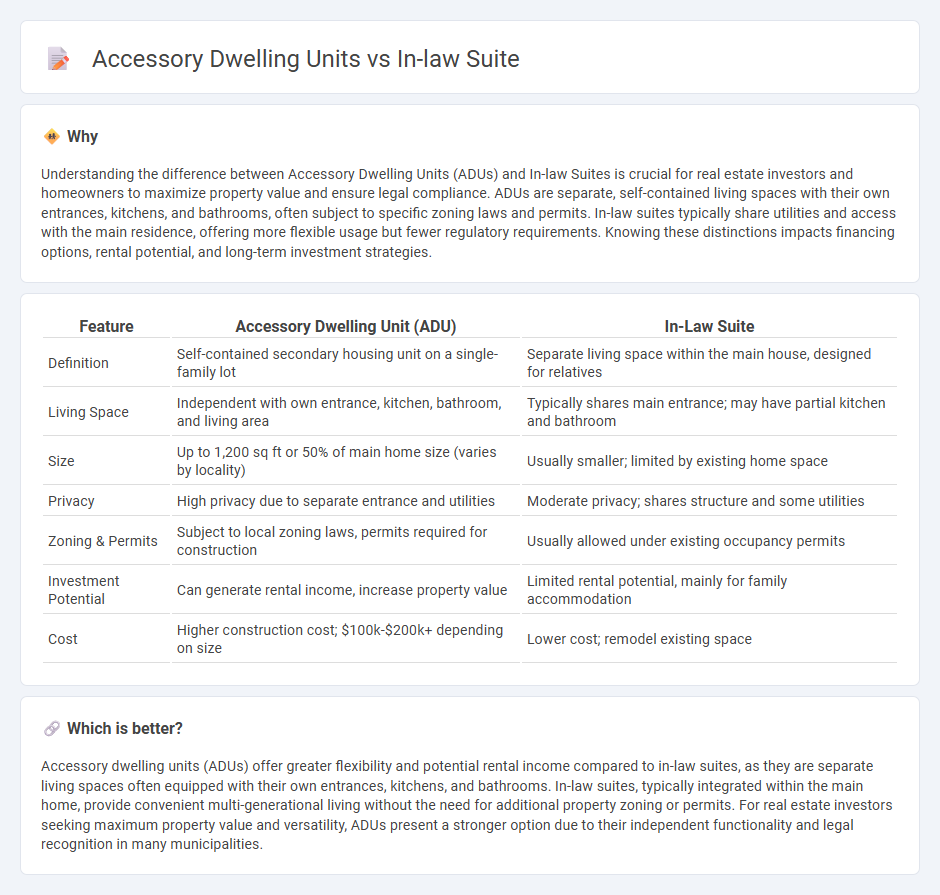
Accessory dwelling units (ADUs) are standalone living spaces on a single-family property, often equipped with separate entrances, kitchens, and bathrooms, providing rental income potential or multi-generational living options. In-law suites are integrated sections within the primary residence, designed for extended family members with private amenities but shared access to the main home. Explore the differences, benefits, and zoning considerations of ADUs and in-law suites to determine the best fit for your property needs.
Why it is important
Understanding the difference between Accessory Dwelling Units (ADUs) and In-law Suites is crucial for real estate investors and homeowners to maximize property value and ensure legal compliance. ADUs are separate, self-contained living spaces with their own entrances, kitchens, and bathrooms, often subject to specific zoning laws and permits. In-law suites typically share utilities and access with the main residence, offering more flexible usage but fewer regulatory requirements. Knowing these distinctions impacts financing options, rental potential, and long-term investment strategies.
Comparison Table
| Feature | Accessory Dwelling Unit (ADU) | In-Law Suite |
|---|---|---|
| Definition | Self-contained secondary housing unit on a single-family lot | Separate living space within the main house, designed for relatives |
| Living Space | Independent with own entrance, kitchen, bathroom, and living area | Typically shares main entrance; may have partial kitchen and bathroom |
| Size | Up to 1,200 sq ft or 50% of main home size (varies by locality) | Usually smaller; limited by existing home space |
| Privacy | High privacy due to separate entrance and utilities | Moderate privacy; shares structure and some utilities |
| Zoning & Permits | Subject to local zoning laws, permits required for construction | Usually allowed under existing occupancy permits |
| Investment Potential | Can generate rental income, increase property value | Limited rental potential, mainly for family accommodation |
| Cost | Higher construction cost; $100k-$200k+ depending on size | Lower cost; remodel existing space |
Which is better?
Accessory dwelling units (ADUs) offer greater flexibility and potential rental income compared to in-law suites, as they are separate living spaces often equipped with their own entrances, kitchens, and bathrooms. In-law suites, typically integrated within the main home, provide convenient multi-generational living without the need for additional property zoning or permits. For real estate investors seeking maximum property value and versatility, ADUs present a stronger option due to their independent functionality and legal recognition in many municipalities.
Connection
Accessory dwelling units (ADUs) and in-law suites both provide secondary living spaces on a single-family property, enhancing housing flexibility and increasing property value. ADUs are independent housing units with separate entrances, kitchens, and bathrooms, while in-law suites typically share connections with the main house but offer private accommodations for extended family. Both options address housing shortages and multigenerational living needs, making them popular solutions in urban real estate markets.
Key Terms
Zoning Regulations
Zoning regulations for in-law suites and accessory dwelling units (ADUs) vary widely depending on local ordinances, often influencing size, occupancy, and placement on the property. In-law suites typically integrate within the primary residence or as an attached unit, while ADUs can be detached structures with separate entrances, subject to distinct zoning standards and permit requirements. Explore detailed zoning guidelines in your area to ensure compliance and maximize property value.
Separate Entrance
In-law suites typically feature a separate entrance, enabling privacy and independent access for residents, making them ideal for multi-generational living. Accessory dwelling units (ADUs) also have separate entrances but are often subject to stricter zoning laws and require additional permits, distinguishing them from simpler in-law suites. Explore the key differences and regulations to determine the best option for your property needs.
Self-Contained Living Space
In-law suites and accessory dwelling units (ADUs) both provide self-contained living spaces with separate entrances, kitchens, and bathrooms, offering privacy and independence. ADUs often have more stringent zoning regulations and size requirements, while in-law suites may be integrated within the main home or attached structures. Explore the key differences and benefits of each option to determine the best fit for multi-generational living or rental income.
Source and External Links
Everything You Need to Know About In-Law Suites - This guide provides comprehensive information on in-law suites, including their types, benefits, and planning considerations for accommodating relatives.
Tips for Planning a Perfect in-Law Suite - This article offers tips and strategies for planning an in-law suite, including budget considerations, zoning laws, and architectural options.
How To Add an In-Law Suite to Your Home - This resource provides practical advice on adding an in-law suite to your home, discussing costs, design options, and remodeling strategies.
 dowidth.com
dowidth.com